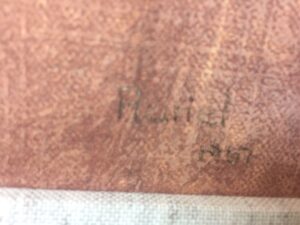 I want to show you how I decipher a artist difficult signature on a work. I’ll use a work I found at a local thrift store as illustration. I found this painting simply signed “A(space)riel,” with a date of 1968. I eventually found this artist as a midcentury modern painter located in New Zealand.
I want to show you how I decipher a artist difficult signature on a work. I’ll use a work I found at a local thrift store as illustration. I found this painting simply signed “A(space)riel,” with a date of 1968. I eventually found this artist as a midcentury modern painter located in New Zealand.
First I drew as accurately as I could, a copy of the signature in the artist’s handwriting style. Paid close attention to the spacing of the letters. Saw that this artist’s hand was rounded, no corners, and he gave each letter the allotted space: the “i” had a short space, the capital “A” a big space. Therefore the large gap between the “A” and the “r” must have contained a larger rounded letter. I tried a rounded “U”, which seemed logical, as Auriel is indeed a name, albeit a first one.
An Artist Signature, a Date, and a Style
Next I looked at the date next to the name. The date “matches” the style of the period. In 1968 this work appeared very forward leaning. Modern for its time, and it indicates this artist MAY have painted other geometric style works in the mid 1960’s. An artist who paints a good abstracted still life probably learned to paint very abstract geometrical nonrealistic compositions too, in a flat picture plane. Now I knew a name, a date, and a style.
 Next I used three of my favorite data bases, each with their own assets: ArtPrice, AskArt, and ArtNet. Some of these sites ONLY work if you have an accurate spelling of an artist’s name but others suggest alternative names. The search box on one site lets you enter JUST first names. Trying that I found about twenty artists with the first name Auriel. Knowing the style of the work and date, I narrowed it down to about twenty living in 1968 and painting in a modernist style. Some sites give a thumbnail example of each work which pops up when I mouse over the names. I looked for very abstracted work in simple bold colors. Sure enough I found an Auriel Shearer who painted in THAT style, from New Zealand of all places.
Next I used three of my favorite data bases, each with their own assets: ArtPrice, AskArt, and ArtNet. Some of these sites ONLY work if you have an accurate spelling of an artist’s name but others suggest alternative names. The search box on one site lets you enter JUST first names. Trying that I found about twenty artists with the first name Auriel. Knowing the style of the work and date, I narrowed it down to about twenty living in 1968 and painting in a modernist style. Some sites give a thumbnail example of each work which pops up when I mouse over the names. I looked for very abstracted work in simple bold colors. Sure enough I found an Auriel Shearer who painted in THAT style, from New Zealand of all places.
Now I researched the dates this artist lived from obit pages. I learned if she painted this work, she was forty-three at the time, born in 1925 and died in 2016. My judgement of this painting is that this is mature work by a career artist. ✅
Files containing a record of a career in art are housed in a small museum in Auckland New Zealand. She worked at her craft, and usually that results in sales. I surmise, however, that because of the art market in New Zealand in the mid 1960s she wasn’t collected broadly. So I didn’t search major auction houses for evidence of sales, because they only carry works that sell for over $1,000.
I did a general Google search noting various “Everything but the House” sites have sold works by this artist. Found two works selling for about $400-600 in the forward thinking college town of Stamford Connecticut.
Artist Signatures a Recent Development
An artist signature on a work in art history is recent, dating to the 15th century, during the Renaissance. Back then the public recognized individual talents above and beyond who commissioned the work. Think of a work for a church in previous eras, NOT signed, in fact the artist never THOUGHT to sign it.
Not only did artist begin to sign work in the 15th century, but collectors often felt PROUD that they afforded to BUY an “expensive” artist’s work and wanted bragging rights.
Signatures aren’t just proof of workmanship, but also mark, by changes, a distinctive new era in the artist’s career or genre, as a Picasso signature does. Even the placement of an artist signature adds to a composition.
Typically, an unsigned canvas means the work wasn’t considered finished, but that isn’t always the case. In the 1950-1980’s those who taught abstract painting often said a signature may deface a clean work. Some artists do NOT sign. But deciphering a signature, if selling a work, might mean the difference of thousands of dollars.
Love this Elizabeth. Very interesting and thanks for posting. Hope you are grand. oxo
Pingback: How to JUDGE a Painting - Elizabeth Appraisals
I love a challenge but the identification of artists via signature is incredibly difficult. The three databases you shared may make the difference. Thanks for your insights Elizabeth.
You love a challenge? Maybe I have one for you that no one can help me with.
What if you can’t make out the writing? I’ve just been given a gorgeous, detailed sculpture of a macaw and no one can make out the signature.
I have half an artists signature cut off horizontally and cannot decipher the letters, of which doesn’t the picture in the above of the specimen have other letters around it. I am sure I could see a B.
I have an oil painting with a signature that has an W, upside down. Ca I send a picture
I have found a beautiful work of art on a board inside a tin heavy frame. I can’t tell if it’s signed.
How would I send a picture?
Send to elizabethappraisals@gmail.com
I have an illegibly signed original charcoal drawing that includes a 1978 copyright notation. Its a large interesting piece that i have had no luck with identifying the artist.
Thank you for any effort s you take. This picture is of papyrus from Egypt, it’s modern I think wondered who painted .thank you
Pingback: Is it a real Van Gogh? - Elizabeth Appraisals